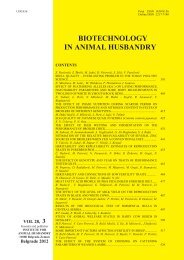Biotechnology in Animal Husbandry - Institut za Stočarstvo
Biotechnology in Animal Husbandry - Institut za Stočarstvo
Biotechnology in Animal Husbandry - Institut za Stočarstvo
Create successful ePaper yourself
Turn your PDF publications into a flip-book with our unique Google optimized e-Paper software.
<strong>Biotechnology</strong> <strong>in</strong> <strong>Animal</strong> <strong>Husbandry</strong> 27 (2), p 285-292 , 2011 ISSN 1450-9156<br />
Publisher: <strong>Institut</strong>e for <strong>Animal</strong> <strong>Husbandry</strong>, Belgrade-Zemun UDC 636.083:636.4<br />
DOI:10.2298/BAH1102285J<br />
PHYSIOLOGICAL ASPECTS OF BEHAVIOUR OF SOWS<br />
AND PIGLETS DURING THE LACTATION PERIOD<br />
M. Joksimović-Todorović 1 , V. Davidović 1 , B. Živković 2<br />
1 Faculty of Agriculture, 11080, Belgrade-Zemun, Republic of Serbia<br />
2 <strong>Institut</strong>e for <strong>Animal</strong> <strong>Husbandry</strong>, 11080, Belgrade-Zemun, Republic of Serbia<br />
Correspond<strong>in</strong>g author: miratodo@agrif.bg.ac.rs<br />
Review paper<br />
Abstract: Maternal ability represents complex <strong>in</strong>teractions between<br />
different forms of behaviour and physiological characteristics. Behaviour and<br />
metabolic processes are partly under the control of endocr<strong>in</strong>e and nervous systems.<br />
Sows are different from other mammals, <strong>in</strong> that sows bear a large number mature<br />
baby, capable immediately to suckl<strong>in</strong>g. Post partum anabolic processes become<br />
catabolic, giv<strong>in</strong>g priority to dairy gland <strong>in</strong> relation to other tissues. Maximum<br />
secretated milk takes place betwen 2. and 3. week. Sows lost <strong>in</strong> body mass and it is<br />
appeared the change <strong>in</strong> value of some bloods parameters. Haemotologic analyses<br />
have suggested the <strong>in</strong>crease <strong>in</strong> total number of leukocytes and neutrophilic<br />
granulocytes and the decrease <strong>in</strong> the number of lymphocytes, monocytes and<br />
eos<strong>in</strong>ophils on the first day postpartum. In the third and fourth week of lactation a<br />
statistically significant fall <strong>in</strong> the number of leukocytes and granulocytes <strong>in</strong> relation<br />
to the first day was observed, along with a significant <strong>in</strong>crease <strong>in</strong> limphocytes,<br />
monocytes and eos<strong>in</strong>ophils. Erythrocyte count, haemoglob<strong>in</strong> concentration and<br />
haematocrit value decreased dur<strong>in</strong>g the lactation period. Level of glucose <strong>in</strong> plasma<br />
is low (it is decreas<strong>in</strong>g for more than 50%), while the level of urea is high, due to<br />
huge prote<strong>in</strong>s available. It can also be noticed that there is a high mobilisation of<br />
body fat an <strong>in</strong>creas<strong>in</strong>g level of NEFA (non-esterified fatty acid). Secretion of milk<br />
is under control prolact<strong>in</strong> and oxytoc<strong>in</strong>. Oxytoc<strong>in</strong> affects on maternal behaviour<br />
and prolact<strong>in</strong> is l<strong>in</strong>ked with tim<strong>in</strong>g of suck.<br />
Key words: behaviour, sow, piglet, lactation.<br />
Introduction<br />
Hormonal changes, prior and post parturition do impel the sow to build a<br />
nest. It is one of the ma<strong>in</strong> characteristics of sow behaviour started by an <strong>in</strong>dividual<br />
24h or 15h prior parturition at the latest (Damm et al., 2003), and is the result of<br />
<strong>in</strong>creased secretion of prostogland<strong>in</strong> F2alfa (Burne at al., 2001). Enclosed hous<strong>in</strong>g




